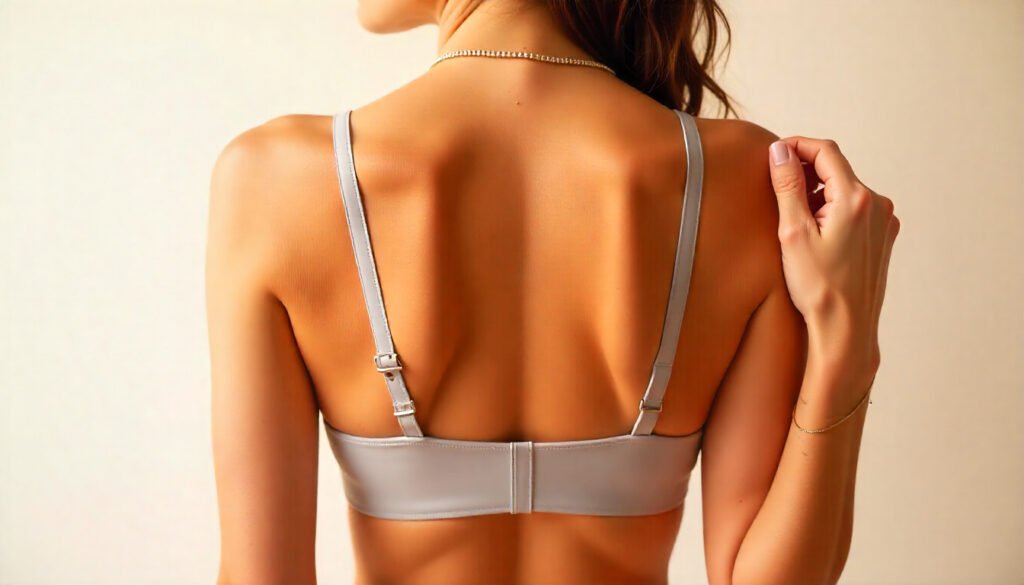When it comes to bras, fit isn’t just about how you look — it’s about how you feel. The right fit can transform your posture, boost your confidence, and make even the longest day more comfortable. A poorly fitting bra, on the other hand, leads to discomfort, frustration, and wasted money on styles that don’t serve you.
Three of the most common bra fit issues women face are gaping cups, spillage, and slipping straps. These problems aren’t just annoying; they’re signs that your bra isn’t doing its job properly — and you deserve better.
In this guide, we’ll break down exactly why these issues happen and, more importantly, how to fix them. Expect practical, no-nonsense solutions that help you find bras that fit, flatter, and support you — the way they should.
Understanding Bra Fit Issues: Why They Happen
Bra fit problems aren’t random — they almost always come down to changes in your body or wearing the wrong style for your shape. Breasts aren’t static; they shift with age, weight fluctuations, hormonal changes, pregnancy, and even exercise routines. What fit you perfectly six months ago might not work today.
Beyond size, breast shape plays a huge role in how a bra fits. Whether you’re full-on-top, full-on-bottom, wide-set, or asymmetrical, certain styles will complement your shape better than others. A bra designed for round, full breasts won’t perform the same on someone with shallower or teardrop-shaped breasts — and that’s where many women go wrong.
Another key factor? Measurements change. Even small shifts in your underbust or bust measurement can turn your best-fitting bra into a source of discomfort. That’s why it’s essential to re-measure yourself regularly — ideally every 6 to 12 months — or get fitted professionally.
Finally, don’t cling to one brand or style just because it once worked. Different brands, even within the same size, fit differently. Trying on a variety of shapes, sizes, and designs is the only reliable way to ensure the bra fits both your current body and your unique breast shape.
Problem #1: Gaping Cups
Symptoms
- Visible gaps between the bra cup and your breast
- Fabric that wrinkles or sticks out, especially at the top of the cup
Causes
- Cup too large: If the cups aren’t filled out, they’ll naturally gap.
- Wrong bra style for your breast shape: Certain shapes — like shallow or wide-set breasts — won’t suit every cup style.
- Weight fluctuation: Changes in weight, hormones, or muscle tone can subtly alter breast volume, making your current bras fit differently.
Solutions
- Adjust the straps: Slight tightening can help the cup sit closer to the body.
- Try a smaller cup size: Often, gaping simply means the cup volume is too big for your current shape.
- Switch to styles designed for your shape: Balconette, demi-cup, or plunge bras can reduce gaping on shallower breast types.
- Use inserts if needed: A temporary fix, inserts can fill minor gaps for a smoother look.
- Re-measure periodically: Regular checks ensure your bras match your current measurements.
- Consider unlined cups: These mold to your natural shape and help minimize visible gaps.
Problem #2: Bra Cup Spillage
Symptoms
- Overflow of breast tissue at the top, sides, or bottom of the cups
- A visible “double boob” effect under clothing
- Cups cutting into the breast creating lumps or bulges
Causes
- Cup too small: The most common reason for spillage is simply not enough room in the cups.
- Mismatch between bra style and breast shape: Certain breast shapes (like full-on-top or round) need styles with more coverage or specific cup designs.
- Tight band affecting cup fit: A too-tight band can distort the cups, pushing breast tissue out and causing spillage.
Solutions
- Go up a cup size: A larger cup provides the space needed to properly contain and support breast tissue.
- Look for full-coverage or T-shirt bras: These styles offer more containment and smoother lines under clothes.
- Match bra styles to your breast shape: For full-on-top or round shapes, opt for higher coverage cups designed to accommodate upper fullness.
- Adjust band size for comfort: Ensure your band isn’t pulling too tight — it should sit snug but not restrictively around your body.
- Re-measure as your body changes: Hormones, weight shifts, and time all impact breast size; update your measurements regularly to stay ahead of fit issues.
Problem #3: Slipping Bra Straps
Symptoms
- Straps sliding off your shoulders throughout the day
- Constantly adjusting straps to keep them in place
Causes
- Loose straps: Straps that aren’t tightened enough will naturally slip.
- Band too loose: A loose band can shift upwards, causing straps to fall out of position.
- Strap placement too wide: Some bras are designed with straps set too far apart for certain body types, especially if you have narrow or sloped shoulders.
- Old or worn-out bras: Over time, elastic loses its strength, making straps less effective at staying put.
Solutions
- Tighten straps appropriately: Straps should be snug enough that you can fit two fingers underneath but not more.
- Ensure the band fits snugly: A properly fitting band anchors the bra and stabilizes the straps.
- Choose closer-set straps: Styles like racerback, leotard back, or T-shirt bras have straps placed closer together to reduce slippage.
- Opt for silicone-lined or textured straps: These materials help straps grip better and stay put.
- Replace old bras: When elastic is stretched out, no adjustment will fix it — time to refresh your lingerie drawer.
- Use accessories: Strap clips, elastic holders, or cushions can keep straps securely in place.
Expert Fit Tips for Every Woman
- Always try before buying: Sizes can vary between brands and styles, so trying on is the best way to ensure a proper fit.
- Measure regularly (DIY or professional): Your body changes over time. Re-measure every 6 to 12 months to keep your size accurate.
- Check band position (level, snug): The band should sit level across your back and feel snug without digging in.
- Move around to test fit: Lift your arms, twist, bend — make sure your bra stays put through real-life movements.
- Know your unique breast shape for best results: Certain styles work better for specific shapes. Understanding yours helps you choose bras that fit and flatter.
Conclusion
The right bra fit can solve most of the common frustrations like gaping, spillage, and slipping straps. A well-fitting bra isn’t just about looking good — it’s about feeling comfortable and supported every day.
Prioritize fit over trends or appearances. The perfect bra is the one that works for your body, not just the one that looks good on a hanger.
Need help finding your perfect size? Use our [Bra Size Calculator] to get started with confidence.
✅ 6 FAQs for This Blog
1️⃣ Why do my bra straps keep falling down even when they’re tightened?
Loose bands or wide-set straps are often to blame, not just the strap adjustment itself.
2️⃣ How often should I remeasure my bra size?
Every 6-12 months or after any noticeable body changes like weight loss, weight gain, pregnancy, or hormonal shifts.
3️⃣ What’s the most common reason for gaping bra cups?
Usually, it’s wearing a cup size too big or picking a style that doesn’t match your breast shape.
4️⃣ How do I know if my bra band is too tight or too loose?
A properly fitting band should sit level and snug; you should only be able to fit two fingers underneath comfortably.
5️⃣ What bra styles help prevent spillage?
Full-coverage, T-shirt, and M-frame bras are ideal for minimizing spillage and creating a smooth silhouette.
6️⃣ Can breast shape really affect how bras fit?
Yes! Breast shape impacts how certain styles fit — knowing your shape makes bra shopping much easier and more successful.

